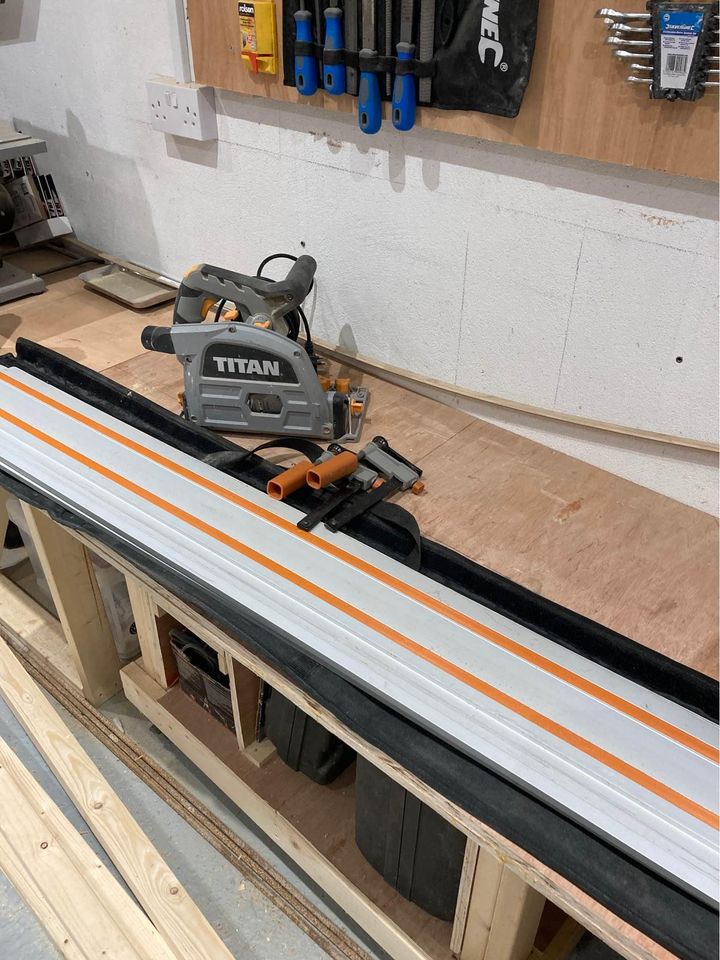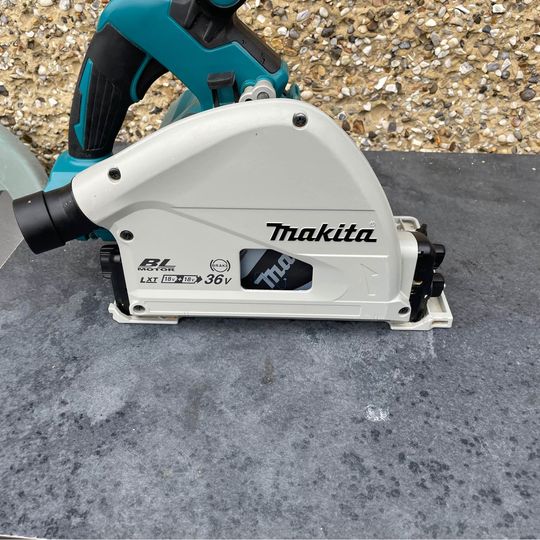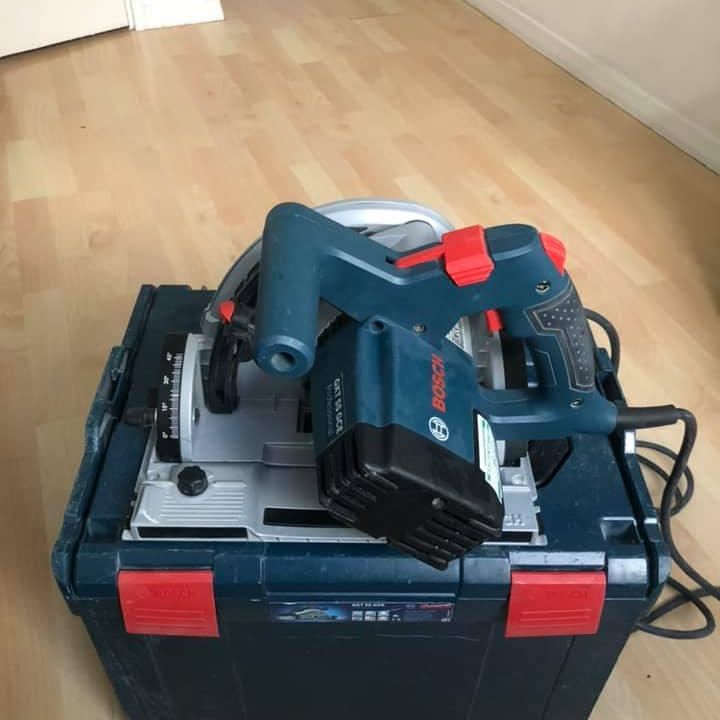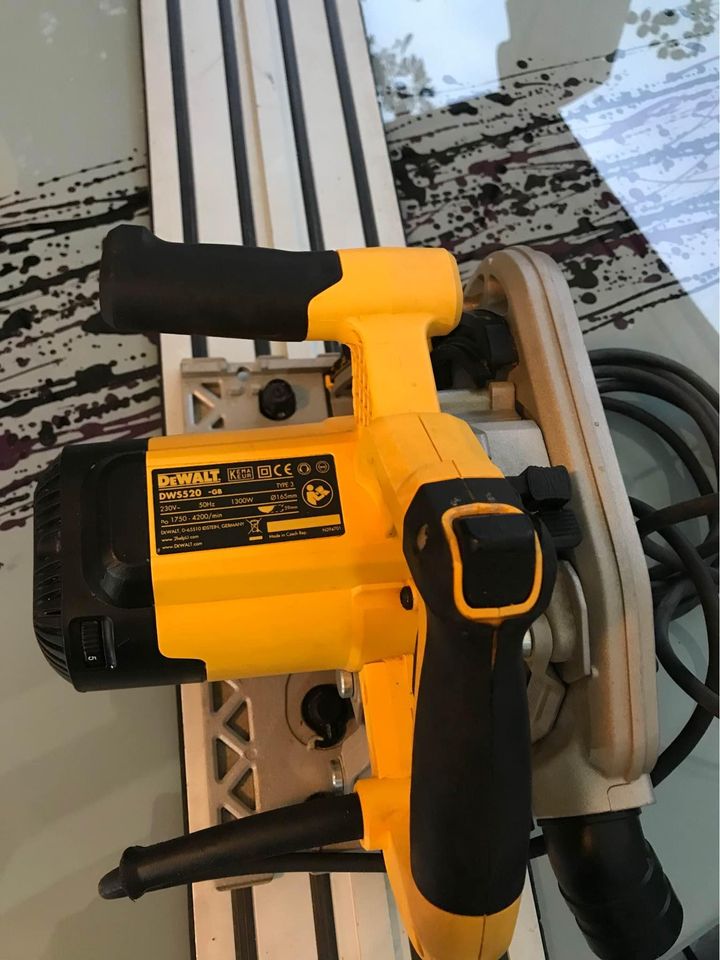Written by Terry Smith
Our site is reader supported so when you click a link to Amazon we may earn an affiliate commission.
Best plunge saw [UK]: Top Makita, Dewault, and Bosch cordless track saws reviewed
This article was last updated on April 23rd, 2022 at 2:11 am
When people first get into DIY, they are usually surprised by just how many different tools, and variations of those tools, there are to choose from. Most people are already aware of different types of screwdrivers, hammers, and a few different saws, but when they start searching for ’best DIY saws’ or something similar, there are always a few that pop-up that they’d never heard of.
This was definitely the case for me when I first started out, and I remember hearing the words track and plunge saw and wondering what my more experienced DIY friend was talking about.
Always being one who hates not knowing things, I went out and hunted down a track and plunge saw and bought my very own. I’ve never looked back. Although I understand that every job is different, and that having the right tool for the right task is paramount for making things easier, I have to say that my track and plunge saw gets used more than most of my tools.
My picks for the top plunge saws in the UK:
Best plunge saw: Makita SP6000J1/1 Plunge Saw
Most powerful plunge saw: Bosch Professional GKT 55 GCE Corded 240 V Plunge Saw
Best track and plunge saw: Festool 561554 TS 55 REQ-Plus GB Plunge Cut Circular Saw
Best alternative to the Makita: Dewalt DWS520KT-GB DWS520/2 Plunge Saw with TSTAK Box
Budget pick: Einhell Plunge Saw TE-PS 165
The thing is, they do what a table saw or circular saw can do, but they also do things that those tools can’t, and this makes them a kind of ‘goldilocks’ saw, giving you the same ability to cut large boards accurately, but offering much more mobility.
Today’s article is dedicated to these wonderful saws, and we will tell you all you need to know about them, including the possible issues you may come across while using them and how to avoid them.
We have also included reviews of the best track and plunge saws that are currently available, so you can save yourself a lot of time and effort searching for the right saw for you.
What is a track and plunge saw?
Track and plunge saws are essentially just a combination of a circular saw and metallic guide, referred to as the track, and are used for cutting up wooden boards, pipes, worktops, and pretty much anything else you can think of.
They are very easy to use, and because of the track they enable pretty much anyone to get very accurate cuts on boards of all different sizes. You simply set up the track on the piece of wood that you’re working on, then sit the plunge saw onto the tracks, and adjust the tighteners until it sits firm but slides up and down easily.
Many DIY practitioners prefer to use a track and plunge saw over a regular circular saw, as they give you much more accuracy without having to do hardly any extra work other than set the track in place.

Of course, you can always use a bench saw for getting precise cuts, but those tools are not exactly mobile, and sometimes it can be difficult cutting really large boards on them. So, again, I prefer to have my track and plunge saw handy.
Another advantage of track and plunge saws is that you can start cutting wherever you like on the workpiece. That means you can cut from the edge if you want smaller separate pieces, or you can cut out a hole in the middle if that’s what’s needed.
So, as I said earlier, they are very handy tools to own. However, just like anything else in this world, they aren’t perfect, and the following section will talk about issues that might arise when using one.
Potential problems when using a track and plunge saw
As good as these tools are, you can still run into trouble if you don’t keep a few things in mind, and while these aren’t exactly ‘flaws’ of the tool and more like limitations due to physics, we thought you’d still want to know about them.
So, here’s the main thing: because you have to fix the track onto the board and then the saw onto the track, there will always be a limit to how thin or flexible the boards can be before you have to think about ways to support them. It’s just common sense, but something that is often overlooked.
Also, you’ll need enough space to use the track so if you are forced into working in confined areas, you might find it frustrating. These tracks are usually made from metal, and so trying to bend one into a small workspace is not a great idea, but there are different sized tracks available; I personally own several.
Finally, the surface that you connect the track to can’t be too bumpy or otherwise oddly shaped, as this will affect how accurate the cuts will be. Working on nice, flat, boards is the way to go if you want the best results.
Examples of using a track and plunge saw
I’ve been using track and plunge saws for quite a few years now, and I’m always pleased with their versatility. I’ve often taken my tools down to friends and family members’ homes to help with DIY projects, and more than a few times those people have gone out and bought their own after seeing how useful they can be.
I originally bought my first track and plunge saw for cutting MDF and plywood sheets, and for this task these tools are tailor made, especially if you’re working on site, but since then I’ve expanded and sharpened my skills.
In the last couple of years alone, I’ve cut window holes in a shed wall, made worktops; compete with spaces for the kitchen sink and cooking hob, trimmed the bottom off a few doors while the door was still on its hinges (yes, you read that right), cut a load of drywall, and even used a plunge saw to cut laminate.
Yes, I’ve done all of that. You can basically think of a track and plunge saw as a mobile bench saw, only you don’t need a bench. As long as the surface you have fixed the track onto is strong and stable enough to take the weight, you should be able to cut it, and cut it extremely accurately.
Best track and plunge saws reviewed
So, now we’ve established that these tools are incredibly useful, we will now offer reviews of the top track and plunge saws you can get delivered straight to your door. We take a very balanced approach to our reviewing and after spending time with the tools featured, we offer up the pros and cons of each one.
1. Makita SP6000J1/1 Plunge Saw 110V 165Mm, 110 V, Blue
With so many great track and plunge saws to choose from, I have to admit that I found it very hard to pick a favourite. In the end, after giving it a lot of thought, I decided that both the Makita SP6000J1 and the Festool TS55 are equally excellent, but I have to start these reviews somewhere, and so I’m kicking things off with the Makita.

This plunge saw comes with a 1.4 metre guide rail, hex wrench, carbide-tipped saw blade, and a carry case. All components are the high quality you’d expect from Makita, and the saw itself feels really solid.
I particularly liked the large power trigger on the Makita as it allows you to use the tool easily even when wearing gloves, and the plunge button on the back of the handle is just as easy to locate and press.
This plunge button acts as a safety feature too, as the saw blade can’t be lowered without it being pressed, and if you let go of the button half way through the movement, the blade will not go any further.
The guide rail that comes with this plunge saw is designed well, and once placed on the workpiece it stays exactly where you want it, with no sliding around. I really never felt the need to use any clamps the whole time I was using the Makita. Here’s a look at that:
There’s plenty of power at hand with the Makita SP6000J1, and I had no problems cutting through multiple pieces of ply and MDF at the same time. The 56mm cutting capacity at a 90-degree angle certainly helps with tasks like this too.
Featuring not one, but two depth stops, it is so easy to cut your timber without accidentally damaging the surface underneath. You set the stop at the desired depth using the incorporated scale, and the blade will go no further each time you make a plunge cut. The secondary depth stop is specifically designed to help you with scoring, and is already preset at 2mm.
The measurements on the plunge stop scale, and also the bevel scale, are very easy to see and read being marked with white numbers on a black background. The bevel itself can be adjusted for various cutting angles, and there is even an option to cut at a wider angle then the 45 degrees the scale stops at.
I could go on and on about all the clever little details on the Makita such as the vacuum port being able to rotate so you can get a good angle, adjustable RPM, and much, much, more. However, I’ll just tidy things up by saying that you will not be disappointed if you decide to buy this track and plunge saw, it is simply on of the best out there for the money.
2. Festool 561554 TS 55 REQ-Plus GB Plunge Cut Circular Saw, 110 V
If there is a track and plunge saw to challenge the excellent Makita SP6000J1, it is the Festool TS55 which shares a lot of features with its rival but also has a few tricks of its very own to distinguish it.
The first thing I noticed was that the depth gauge had two sets of measurements on it, and this for when using the saw with the track or without it, which I thought was very practical. There are controls to fine tune the depth adjustment, and the main adjuster slides up and down smoothly and easily with a press of the thumb, although I have to say that this didn’t feel like the strongest part of the machine.
The dual bevel controls are just as easy to adjust and allow you to change the angle through a 45-degree range. In addition, there is another knob that gives you an extra 2 degrees of cutting angle when activated, and yet another one at the other end of the scale that enables you to make 91-degree angled cuts.
As with the Makita, a lot of thought has gone into making this track and plunge saw user-friendly. From the large and easily located controls, to little things such as the Allen key being stored in the handle, these little details really do help.
Changing blades on the Festool TS55 is nice and easy. You just unlock the blade using the controls on the handle, then, with the provided Allen key, loosen the blade and remove it. To fit a new blade, you just reverse the process. It’s so simple and intuitive that beginners will have no problem with it at all.
The Festool TS55 has variable speed controls and you can select from 6 presets using a brightly coloured dial. You can change speed while the blade is spinning and you will notice an instant audible change through each setting.
I was impressed with just how well this plunge saw connected to the supplied guide rail, and just how easy it was to set up. It only took a few twists of the knobs on the base and the tool felt really solid on the track.
To reduce the risk of kickback, there is a small plastic track stop included with the track and plunge saw, and again, it couldn’t be simpler to use. Just slide it into place and twist the knob on top to tighten and secure it.
The track that comes with the tool is made from aluminium, meaning that it won’t suffer from rust, and it also means its nice and lightweight. The rubber strips on the back of the track do a great job of keeping it in place on the material you’re cutting and there isn’t any slipping or sliding around.
With other extras like the replaceable splinter guide, groves for using clamps, and a powerful motor that has great soft start and braking features, it is easy to see why Festools are such a popular brand with DIY practitioners and workmen alike. Simply outstanding.
3. Bosch Professional GKT 55 GCE Corded 240 V Plunge Saw
Offering more raw power, and a deeper cut than most of its closest competitors at 57mm for a 90-degree cut, and 42mm for 45 degrees, the Bosch GKT 55 GCE is yet another cracking track and plunge saw vying for your attention.

However, there are a couple of small things that I found slightly irritating that kept the Bosch out of the top spot, and I’ll point this out to you now.
The first thing was the depth gauge. Now, it is very clearly marked and solidly built, and you can flip the switch for different measurements for working with or without a track, so all is good there. The problem I had was that the way the adjuster has been designed, it kind of jumps and so it takes longer, and more concentration, to set it precisely.
The second little niggle is that the motor doesn’t sound as if it is running as smoothly as the Makita or the Festool model, especially when you first kick it into life. Having said that, it is more powerful, and I had no problems cutting through 2 inches of hardwood smoothly and accurately, so it doesn’t affect performance.
There was no guide included at the price we paid for this plunge saw, but I have seen it all for sale as part of a set. I had already read up on this product and knew it would fit onto tracks from Makita, Dewalt, etc. so I saved myself the money. No matter what track we tried this plunge saw was as stable as it gets and never once did, we have any problems.
Bosch tools have always impressed me with their ruggedness and solidity, and there are no signs of that slipping here. The outer casing, knobs, levers, and everything else, all feel as durable as they should. The large handle on the top is particularly solid, and I felt really confident putting my weight into the tool as I worked.
The usual features that you would expect like variable speed controls, quick blade changes, and a fine adjustment screw for setting the depth are all present on the Bosch, but there is no scoring feature here. Personally, I found that the tools cut so well that there were no signs of any splintering, but some people might feel they really need to score before cutting.
So, to sum up the Bosch GKT 55 GCE, I would have to say it is very powerful, cuts incredibly well even through thicker and harder materials, and is very well-built. The motor sounds a bit ‘grindy’ for the first second but that goes away as the speed builds up, and the depth gauge is a bit fiddly, but overall, it is still a great tool and one that is over 150 quid cheaper than the Makita or Festool models.
4. Dewalt DWS520KT-GB DWS520/2 Plunge Saw with TSTAK Box, 1300 W, 240 V
Dewalt’s DWS520KT plunge saw is a capable tool, and under other circumstances would probably be placed higher on this list. However, when in the company of products like the Festool and Makita track and plunge saws, it just falls a little short in some areas.

I suppose the best way I can describe it is that both the Makita and festool plunge saws feel like they would be just as at home in the workshop or on site, as they would be in a DIY enthusiasts’ garage. On the other hand, the DeWalt gives the impression that it is better off as a DIY oriented tool.
That’s not to say it isn’t a very good tool, it has plenty of power coming from the 1300-watt motor, and while the top speed of 4000 rpm isn’t quite as fast as the aforementioned other brands’ plunge saws, it is still enough more than enough for most home-based tasks.
One thing I really liked about this Dewalt track and plunge saw is the actual plunging action. Unlike the Festool, for example, which moves in one continuous arc, the DeWalt is kind of done in a 2-step way to follow the natural movement of the arm. This is done very smoothly though, and feels almost like one action.
This tool, like all the other top models, is very easy to set up and operate, with clearly marked gauges, easy to locate and use controls, and quick blade changes. It does feel a little heavier than some when you’re sliding it along the track, but it isn’t anything that you would notice if you hadn’t tested a load of these tools back-to-back.
Now, the Dewalt DWS520KT plunge saw is priced much cheaper than the likes of the Makita, but unfortunately, some of the areas where costs have been cut can be seen if you look closely. For example, the plastic part of the base that locks the tool into the track isn’t as thick and durable as it should be, and it feels as if it might wear down through normal use as it runs up and down.
Performance-wise, I can’t knock this track and plunge saw on jobs like cutting MDF, and the quality of the cuts was just as good as any of the other tools we tested. When I held the piece that I’d cut side by side against one I’d done with the Makita, I couldn’t tell the difference. I doubt it would handle thick hardwood as well, but not many of these tools can.
So, I guess what I’m trying to say is, if you just want something for light home use, and you don’t want to spend the extra 200 quid or so for a Makita or Festool, I think you’d be happy enough with the Dewalt.
6. Einhell Plunge Saw TE-PS 165
We finish off our reviews with another budget offering, this time from Einhell and their TE-PS 165 track and plunge saw.
With its 1200-watt motor and 165mm cutting blade, it actually cuts really well for a low cost saw, not quite as good as the Evolution power tools offering, but still producing clean cuts in materials I would expect DIY enthusiasts to be using like MDF. On closer inspection of the blade that comes with the tool, I saw that it isn’t the highest quality, so it might perform better if you swapped it.
At the price we paid for it, which was around 95 pounds, the track wasn’t included and so we had to spend extra and buy one separately. I had done some research and read comments that people had had problems using certain universal tracks with this plunge saw, so I hunted down one that would work.
The Einhell TE-PS 165 was easy enough to set up in the track, and adjusting the base so that it sat in there without any play was quick and simple. The way the tool slid along the track wasn’t as smooth as more expensive models, but that was to be expected, and overall, it worked pretty well.
Unfortunately, this track and plunge saw suffers from the same thing as the Evolution power tools model, in that the vacuum port doesn’t work that well. The plastic used for this part of the tool just isn’t up to the job and it is sure to break, crack, etc. in a very short amount of time. Even on our first use, there was still a lot of dust escaping.
There are a few other places too where I noticed that components were made of weaker / thinner materials, and in some cases, these were parts that play a part in the safety aspects of the tool. Now, I have to be honest and say that nothing broke while we were testing the tool, but I just didn’t feel that confident in the durability of certain parts of it.
I guess I might be being a little bit hard on the Einhell and the Evolution tools track and plunge saws, as they are low budget models. However, when you’ve spent time using the Makita, Festool, and Bosch products, it’s hard not to recommend that people shell out the extra and get something that is sure to last them for years instead.
Thanks for reading, but that last review brings this article to its end. We will, of course, update this page when new products hit the market that we believe deserve a spot, so pop back from time to time.
This site of ours contains hundreds of articles on a wide range of gardening and DIY based topics. We have product reviews of all manner of tools, DIY how to articles, tips on gardening and growing, and a lot more.
So, if you have time, please explore this site that we have worked so hard on and we are positive you will find something that you like.
















